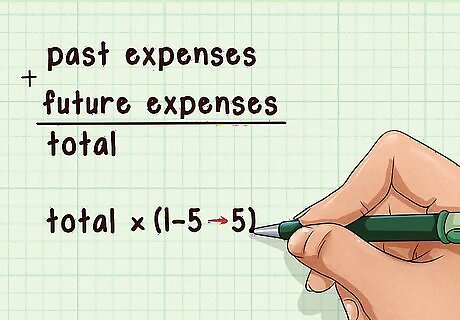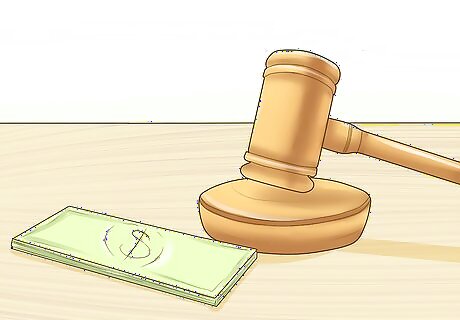
views
X
Research source
[2]
X
Research source
Totaling Economic Damages

Gather reports and receipts. Economic damages consist of provable expenses incurred as a result of the injury or contract breach claimed by the plaintiff. Since these amounts must be supported by evidence, bills or payment receipts generally are required. If you're dealing with a breach of contract, financial reports showing your profits and losses before and after the breach will be beneficial. You also should gather any invoices for other expenses, such as if you had to hire someone else to finish a job after a contractor breached your contract. For personal injury cases, documents might include medical bills and receipts for prescriptions or medical equipment such as crutches that you had to buy. Pay check stubs and work schedules will prove the amount of money you make if you had to miss work as a result of your injury.

Add up any medical expenses. In a personal injury case, medical expenses include doctor or hospital bills as well as the cost of any drugs, therapy, or other medical treatment the plaintiff needed as a result of their injuries. You'll also want to include any over-the-counter medicines or medical equipment you had to purchase. For example, if you treated your pain from an auto accident by taking an over-the-counter pain reliever, the cost of that medication should also be considered part of your medical expenses. Generally, the expenses you include are unreimbursed, out-of-pocket expenses – not anything covered by insurance. This could include your deductibles or co-pays, as well as over-the-counter or alternative treatments that weren't covered by insurance at all.

List expenses for property damage. These expenses can come about in a personal injury case or a breach of contract case. If property was damaged as a result of the defendant's actions, the plaintiff can recover the expenses they incurred to repair or replace that property. For example, if you were in a car accident, you may have personal injuries and property damage. The repair bills for your car should be included as part of your actual damages. Just as with medical expenses, your property damage expenses should include only expenses that you had to pay out of pocket – not anything covered by your insurance. In a breach of contract case, you also might have property damages. For example, a construction contractor might breach their contract and abandon a work site, resulting in damage to the property.

Calculate any lost wages. If the plaintiff had to miss work as a result of their injuries, they are entitled to recover those wages from the defendant. Lost wages also may occur in a breach of contract case, if the plaintiff missed work because of the breach. Typically lost wages include only unpaid amounts for hours or days that you couldn't work because of your injuries or other problems. However, if you took paid time off, you should include those hours as though you were not paid for them. You lost those paid hours, so you still lost the same value. Likewise, if you took unpaid vacation time that was accrued time off, you may be able to get some value for those hours.

Include other actual losses. Particularly in a breach of contract case, the plaintiff may have incurred other expenses or losses, such as the loss of profits, legal costs, or travel expenses. For example, if you are a subcontractor, you may have had to settle a lawsuit or breach another contract as a result of the defendant's breach. If you had to get a babysitter at any time so you could deal with your injuries or with the breach of contract, the amounts you paid the babysitter can be included in your actual expenses. Basically, any costs you have that relate to the breach of contract or the personal injury you suffered, they should be included in your total economic damages.

Estimate future losses and expenses. Not all damages from a personal injury or breach of contract occur in the past. There may be ongoing costs associated with the acts of the defendant, and the plaintiff is entitled to compensation for these. Particularly in a personal injury lawsuit, you may not be fully recovered or released from your doctor when you initiate your lawsuit. You can use your past medical bills, coupled with how long your doctor estimates it will take you to recover, to estimate your future medical expenses. The percentage of those expenses that will be covered by your insurance should be taken into consideration as well.
Determining General Damages

Find out if general damages are available in your case. General damages typically consist of damages for pain and suffering. These types of damages typically are not available in breach of contract cases. As much as the breach of contract may have been upsetting or mentally taxing to you, judges typically don't consider awarding damages for "pain and suffering" in contract cases. Although you can add them to your settlement calculations if you feel so inclined, you're unlikely to get the other party to agree to pay them, since the other party will know the odds they'll have to pay them after a trial are slim to none. However, there are other general damages that you may be able to recover in breach of contract cases. These include money for things such as loss of business opportunities or damage to your business reputation. Due to the difficulty of proving these damages – as well as damages for pain and suffering in personal injury cases – it's important to talk to an attorney when you attempt to calculate these settlement amounts.

Total your medical and other special damages. To use the multiplier method to calculate your general damages, you must first total your past and estimated future medical expenses. This total will then be multiplied by a value ranging from 1.5 to 5. Special damages are those economic damages that are quantifiable and can be proven with reference to receipts or financial reports. Your medical damages will include your unreimbursed hospital or doctor's bills, the costs for prescription drugs or other assistive devices, as well as over-the-counter medications and any bills for therapy. Medical damages should include both your past and estimated future medical expenses. This total of special damages is the amount that will be multiplied by a specific number called the "multiplier" to arrive at the total value of your case.

Consider the relative fault of you and the defendant. Whether calculating general damages using the multiplier method or any other method, you can't expect to get a full recovery of all damages if you were partly to blame for the injury you incurred. A civil lawsuit is designed to make the person responsible pay for the damages that resulted from their acts. But if both parties are to some degree responsible, they'll share the costs. For example, if you were involved in a car accident and each of you was equally at fault for that accident, you can only expect to get the person your sue to pay for 50 percent of your damages. However, if they were 80 percent at fault for the accident, they should pay most if not all of your damages.

Determine how long it will take you to recover. You generally will need the medical opinion of a healthcare professional to make this estimation, and you may need more than one. The period of time it takes to recover from the injury may indicate a full recovery or an optimal recovery. Keep in mind that if the other party doubts or disagrees with your doctor's estimation, they may request that you be evaluated by another doctor of their choosing. You typically can expect a higher settlement amount for longer recovery times. In terms of using a multiplier, a longer recovery time would mean a larger multiplier would be used. For example, if your doctor believes that you will be fully recovered from your injuries within six months, that six-month period would affect the multiplier. Depending on the severity of your injuries, a six-month recovery period might merit a multiplier of 2, while a two-year recovery period would merit a multiplier of 3 or 4.

Evaluate your degree of disability. If the injury has left you with some degree of disability, that disability typically is valued by calculating the percent to which your normal functioning is impaired. This impairment can be to a specific part of your body, or to your body as a whole. Disability ratings are frequently used in workers' compensation and disability cases, but the same principals may be used in calculating settlement amounts in personal injury cases as well. A doctor uses the permanent impairment guide published by the American Medical Association to evaluate the level of disability you retain after medical treatment and therapy are complete. For example, suppose you broke your leg in an auto accident. After the bone has healed, you still have somewhat limited mobility compared to before the injury, and cannot stand for long periods of time or walk long distances. From this, your doctor may conclude that you have a percentage of permanent disability as a result of the accident. Impairment typically is expressed as a percentage, and this percentage is related either to the individual body part or the body as a whole. So after that broken leg, your doctor might conclude that you have a 10 percent impairment to your leg.

Consider how the injury affects your quality of life. Both physical and mental injuries can result in a significant loss to your quality of life. This can include anything from not being able to participate in activities you once enjoyed to having anxiety or other difficulty relating to others. For example, if you broke your leg in an auto accident, you can no longer walk or run while your leg is in a cast. If you were a member of a community soccer team, you wouldn't be able to play. Your loss of ability to participate in the community soccer league would be something to consider separately from the injury itself when calculating your settlement amount. Essentially, anything you used to do frequently before the injury that you can no longer do after the injury will have an impact on your quality of life and can impact the relative value of your case. Many states also recognize "loss of consortium," which refers to the negative impact an injury can have on your romantic relationship with your spouse or partner.

Try the "per diem" method. This method, named after the Latin for "per day," assigns a dollar amount for each day you were injured and then totals the days before your recovery. This method is used to determine the amount of money to which you're entitled for your pain and suffering as a result of the injury. Particularly if you suffered a relatively minor injury from which a full recovery is expected, the per diem method may get you a more generous settlement amount than the multiplier method. To find the day rate, you would need to look at how much you make at work. If you make $30,000 a year, for example, your day rate would be $120 a day (assuming 250 working days per year). Using the day rate is particularly helpful if you have made a full recovery from your injuries, without any remaining disability or impairment. The per diem method can't be used effectively for long-term or permanent disability, because you have no way of knowing how long you'll live.

Decide whether you might be eligible for punitive damages. In some cases, whether based in personal injury or in breach of contract, you may be entitled to punitive damages if the defendant's actions were intentional or particularly egregious. As indicated by the name, punitive damages are intended to punish the defendant for acts that are seen as particularly wrongful. Some states don't allow punitive damages at all. In others, state law caps punitive damages, not allowing plaintiffs to get more than that amount. Punitive damages also may be available in a breach of contract case. Review your contract to see if it has a clause relating to punitive damages. Keep in mind that punitive damages are awarded by a jury, but seldom will a defendant agree to a settlement that includes punitive damages. So while it's important to consider it, punitive damages shouldn't be included in your settlement calculations.
Setting Your Settlement Range

Evaluate the strength of your case. To finally determine how much a legal case is worth, look at the elements that must be proven at trial. Consider how much evidence is available to prove each of those elements. If you've hired an attorney, they'll be able to help with this evaluation. The relative strength of the plaintiff's case also depends on whether the defendant has any strong defenses, and vice versa. When you evaluate evidence, keep the burden of proof in mind. In a civil case, the elements of a claim must only be proven by a preponderance of the evidence. This means the plaintiff must prove that their version of events more likely than not happened. It's a much lower burden than the "beyond a reasonable doubt" standard prosecutors must meet in criminal cases. On the other hand, the defendant has the burden of proof for any defenses they raise. The same "preponderance of the evidence" standard typically applies.

Look at your actual damages. Actual damages are the specific amount you've already spent repairing the damage or treating the injury caused by the defendant, or specific losses you've incurred as the result of a contract breach. Actual damages also may be referred to as economic damages, or as special damages. All of these names mean the same thing. Typically, this amount will represent the lowest number of your settlement range. However, it may be adjusted downward depending on other factors. For example, if both parties are equally responsible for the accident that resulted in the plaintiff's injuries, the minimum settlement would be 50 percent of the plaintiff's economic damages.

Take court costs and legal fees into account. Civil litigation is expensive and time-consuming. These costs can make a lower settlement reached shortly after you file your complaint more valuable than a much higher award at trial. For example, the discovery process in a civil case can cost thousands of dollars. It may be reasonable to take a lower settlement, even if it's several thousand less than your case is worth, if it means you could avoid incurring these costs. By the same token, if you've already spent a significant amount on litigation of the court case, the settlement should take these expenses into account – even if court costs and legal fees are not specifically addressed. If you've hired an attorney, rely on their estimate of court costs and legal fees. These amounts also should be discussed in your retainer agreement. If you have a breach of contract case, look at whether your contract provides for the breaching party to pay the other party's attorney's fees. If so, these will be considered separately from the settlement amount you calculate, then added to the final settlement amount.

Assess the probability of different outcomes. Based on the strengths and weaknesses of the case, you can assign probabilities as a percentage that indicates the likelihood that each particular outcome will occur. This sort of analysis typically should be left up to your attorney. But if you have a good understanding of the amount of evidence you have, and the evidence needed to prove the various elements of your case, you can make a good estimate yourself. For example, suppose there are four specific things that you must prove to show that the defendant was responsible for your injuries. You have definitive, iron-clad proof of three of those things, but only circumstantial evidence of the fourth thing, you might estimate your probability of winning at trial at 75 percent.

Arrive at a valuation of your case. Based on your assessment of the strengths and weaknesses of your case and your probability analysis, you should be able to find a specific amount that your case is worth. Your settlement range should be built around this particular valuation, with the lower end of the range representing the actual costs you've incurred as a result of the defendant's acts. Keep in mind that during settlement negotiations, you and the defendant most likely will meet somewhere in the middle. For this reason, you should set the upper end of your range high enough that you have room to negotiate without going below the amount you've decided is the true value of your case.




















Comments
0 comment